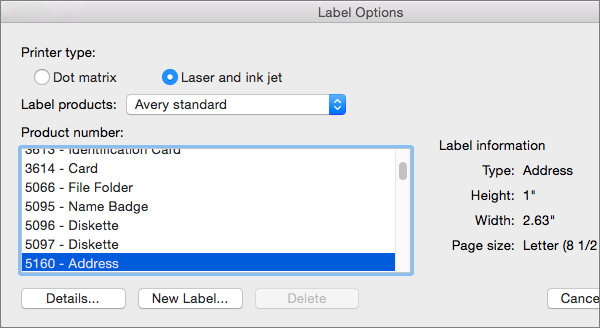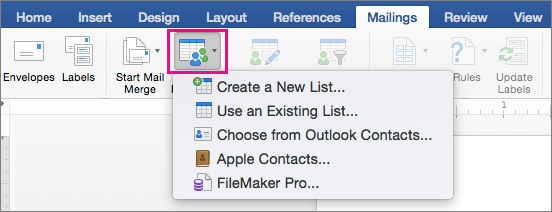Create mailing labels in Word by using mail merge
When you want to use labels to send a mass mailing to your address list, you can use mail merge to quickly create a sheet of address labels. Each label contains an address from your list.
These are the documents involved in creating and printing labels using the mail merge process:
-
Your main document.
This is the document you use to set up the layout of the labels for all the labels in the mail merge. You can also set up any content that you want repeated on each label, such as a company logo or your return address on shipping labels. -
Your mailing list.
Your address list is the data source that Word uses in the mail merge. It's a file that contains the addresses to be printed on the labels. -
Your merged document.
This document is a combination of the main document and the mailing list that is used to print individual addresses on the labels.
Step 1: Set up your mailing list
The address list can be Excel spreadsheet, a directory of Outlook contacts, or an Apple Address Book. It contains the records Word pulls information from to build the addresses for the labels.
-
If you don't yet have a mailing list, you can create a new list in Word during mail merge. Before you start the mail merge process, collect all of your address lists.
-
If you're using an Excel spreadsheet, make sure the column for ZIP or postal codes is formatted as text so that you don't lose any zeros.
-
If you want to use your Outlook contacts, make sure Outlook is your default email program.
Step 2: Prepare the main document for the labels
-
On the Mailings tab, choose Start Mail Merge > Labels.

-
In the Label Options dialog box, choose your label supplier in the Label products list.

-
In the Product number list, choose the number that matches the product number on your package of labels.
Tip: If none of the options match your labels, choose New Label, enter your label's information, and give it a name. Choose OK to add the new label to the Product number list.
-
Choose OK to close the Layout Options box.
Your document now displays a table with an outline of the labels (the dimension and shape of the labels depends on the label product you chose). If you do not see the table, on the Table Layout tab, choose View Gridlines.
-
On the File menu, choose Save to save your document.
Step 3: Link your mailing list to your labels
-
On the Mailings tab, choose Select Recipients, and then choose an option.

Choose
To
Create a New List
Start a new address list while you're setting up the mail merge
Use an Existing List
Use an Excel spreadsheet, or another type of data file, as your address list
Choose from Outlook Contacts
Select names directly from your Outlook contacts for your address list
Apple Contacts
Select names directly from your Apple Address Book for your address list
FileMaker Pro
Import data from a FileMaker Pro database
-
If you selected Create a New List, follow these steps:
-
In the Edit List Fields dialog box, Word automatically creates fields for some basic information, such as first name, last name, and address. If you want to add a new field—for example, a message field—add it now, so you can fill it in when you type the entries. Under New field name, type the name of the field you want to add and then click the plus sign (+).
Tip: To change the order of the fields, click the field you want to move, and then click the up or down arrows to move the field where you want it.
-
When all of the fields are set up the way you want them, click Create to create the list.
-
-
If you selected Use an Existing List, follow these steps:
-
Browse to the file you want to use and choose Open.
-
In the Open Workbook dialog box, select the sheet you want to use, and leave Cell Range blank to use the entire worksheet or enter a cell range for the data you want to use, and then choose OK.
-
-
If you selected Choose from Outlook Contacts or Apple Contacts, follow these steps:
-
Choose Filter Recipients to select the recipients you want to include.
-
For Outlook contacts, in the Query Options dialog box, next to List mail merge recipients by, select Complete record. In the list of contacts, select the contacts you want to include in the mail merge, and then choose OK.
-
For Apple contacts, in the Query Options dialog box, under Apple Group Contacts, choose the group you want to include in the mail merge, and then choose OK.
-
Step 4: Add and format merge fields
-
On the Mailings tab, choose Insert Merge Field and select the field you want to show on your labels.

Continue adding fields until you've added all the information you want on the labels, and then choose OK.
-
On the Mailings tab, choose Update Labels to add the fields to all of the labels.
-
Format the fields in the first label so it looks the way you want the rest of your labels to look. For example, include a space between First and Last name fields and press Return to start a new line for the Address field.
-
On the Mailings tab, choose Update Labels to apply the formatting to all of your labels.
Step 5: Preview and print the labels
-
On the Mailings tab, choose Preview Results to see how the labels will look.

Tip: Choose Preview Results again to view, add or remove merge fields.
-
To make additional formatting changes, format the first label, and then, on the Mailings tab, choose Update labels.
-
When the labels look the way you want, on the Mailings tab, choose Finish & Merge > Print Documents to complete the mail merge.

Tip: If you want to review and update each label individually before printing, on the Mailings tab, choose Finish & Merge > Edit Individual Documents. When you're done, choose File > Print to print the labels.
See also
When you perform a mail merge, Word inserts the records from a data source, or recipients list, into your main document. A recipients list for a mail merge operation can be an Excel sheet, the Office Address Book, a FileMaker Pro database, a Word document, or a delimited text file.
Important: You must have an existing recipients list, such as a Word document that has addresses, to complete this procedure.For more information about how to set up a recipients list, see Create a data source for a mail merge
-
On the File menu, choose New Blank Document.
A new, blank Word document opens. This becomes your main document.
-
On the View menu, choose Print Layout.
-
On the Tools menu, choose Mail Merge Manager.
-
Under 1. Select Document Type, select Create New, and then choose Labels.
-
Under Printer information, choose the type of printer that you use.
-
On the Label products pop-up menu, click the manufacturer of your labels.
Tip: For more label products, on the Label products pop-up menu, choose Other.
-
Under Product number, select the type of label that you have, and then choose OK.
Tip: For information about the margins and other characteristics of a label, choose Details.
-
In the Mail Merge Manager, under 2. Select Recipients List, choose Get List, and then select the source for the recipients list (for example, Office Address Book).
-
On the Insert Merge Field pop-up menu, choose a field name in the list (for example, FirstName).
Word adds the field name to the Sample label box.
Tip: To return to this dialog box later, in the Mail Merge Manager under 2. Select Recipients List, choose Add or remove placeholders on labels
 .
. -
Repeat step 9 for each field that you want to appear in your labels.
-
After you add all the fields that you want, choose OK.
Your field names are copied into all the labels in your main document.
-
In your main document, edit the first label to add spaces, commas, and carriage returns where you want them.
-
In the Mail Merge Manager, under 2. Select Recipients List, c Fill in the items to complete your document
 .
.Word applies the formatting that you use for the first label to all the labels.
-
To finish your labels, do one of the following:
| To | Do this |
| Preview your labels | In the Mail Merge Manager, under 5. Preview Results, choose View Merged Data |
| Print your labels immediately | In the Mail Merge Manager, under 6. Complete Merge, choose Merge to Printer |
| Create a document that contains your merged labels that you can save | In the Mail Merge Manager, under 6. Complete Merge, choose Merge to New Document |
See also
Create and print a single mailing label
 .
. .
. .
.
No comments:
Post a Comment